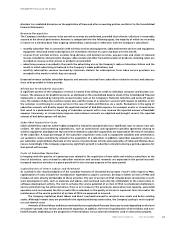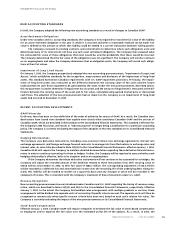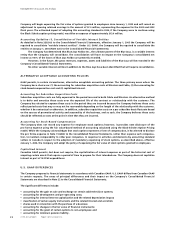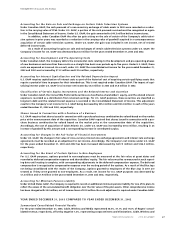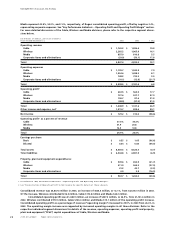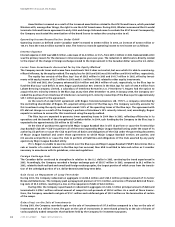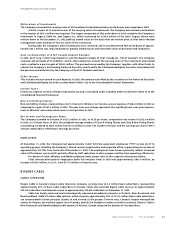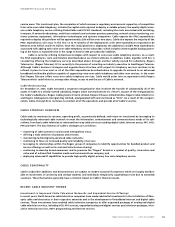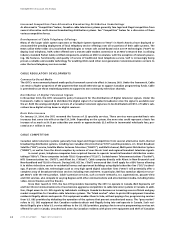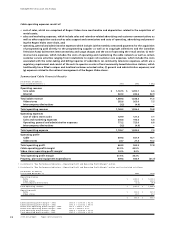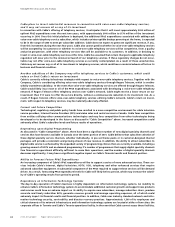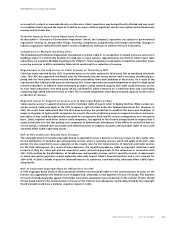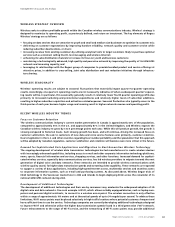Rogers 2003 Annual Report Download - page 35
Download and view the complete annual report
Please find page 35 of the 2003 Rogers annual report below. You can navigate through the pages in the report by either clicking on the pages listed below, or by using the keyword search tool below to find specific information within the annual report.
2003 Annual ReportRogers Communications Inc. 33
service areas. This investment plan, the completion of which assumes a regulatory environment supportive of competition
from voice-over-cable telephony, includes the capital costs required to deploy a scalable primary line quality digital voice-
over-cable telephony service utilizing PacketCable and DOCSIS standards, including the costs associated with switching,
transport, IP network redundancy, multi-hour network and customer premises powering, network status monitoring, cus-
tomer premises equipment, information technologies and systems integration. Cable expects the PP&E expenditures
required to deploy this platform will be approximately $200 million over two years. Cable also expects the majority of the
PP&E expenditures will occur in the first 12 to 18 months of the deployment, with 2004 expenditures expected to be
between $140 million and $170 million. Once this initial platform is deployed, the additional variable PP&E expenditures
associated with adding each voice-over-cable telephony service subscriber, which includes uninterruptible backup power-
ing at the home, is expected to be in the range of $300 to $340 per subscriber addition.
Cable is currently refining its business strategies with respect to voice-over-cable telephony services. As a result,
the PP&E expenditures, costs and timeline described above are initial estimates. In addition, Cable, together with RCI, is
considering offering the telephony services described above through another wholly owned RCI subsidiary, Rogers
Telecom Inc. (Rogers Telecom). RCI is currently in the process of recruiting an industry executive to lead Rogers Telecom.
Although Cable’s business strategies and organizational structure with respect to telephony services continue to be
refined, it plans to incur most or all of the PP&E expenditures described above to upgrade its network to an advanced
broadband multimedia platform capable of supporting voice-over-cable telephony and other new services. In the event
that Rogers Telecom offers voice-over-cable telephony services, Cable would enter into an agreement with Rogers
Telecom which could relate to, among other things, access to and the use of Cable’s network.
Cable Restructuring
On December 31, 2003, Cable executed a corporate reorganization that involved the transfer of substantially all of the
assets of Cable to a wholly-owned subsidiary, Rogers Cable Communications Inc. (“RCCI”). As part of the reorganization,
the Cable’s subsidiaries, Rogers Cablesystems Ontario Limited, Rogers Ottawa Limited/Limitée, Rogers Cable Atlantic Inc.
and Rogers Cablesystems Georgian Bay Limited, amalgamated with and continued as “RCCI”. As a result of the reorgani-
zation, Cable, through RCCI, continues to conduct all of the operations and provide all of Cable’s services.
CABLE STRATEGY OVERVIEW
Cable seeks to maximize its revenue, operating profit, as previously defined, and return on investment by leveraging its
technologically advanced cable network to meet the information, entertainment and communications needs of its sub-
scribers, from basic cable television to advanced two-way cable services including digital cable, Internet access, PPV, VOD,
PVR and HDTV. The key elements of Cable’s strategies are as follows:
• clustering of cable systems in and around metropolitan areas;
• offering a wide selection of products and services;
• maintaining technologically advanced cable networks;
• continuing to focus on increased quality and reliability of service;
• leveraging its relationships within the Rogers group of companies to identify opportunities for bundled product and
service offerings as well as for cost and infrastructure sharing;
• continuing to develop brand awareness and to promote the “Rogers” brand as a symbol of quality, innovation and
value and of a diversified Canadian media and communications company; and
• deploying advanced IP capabilities to provide high quality digital primary line voice telephony service.
CABLE SEASONALITY
Cable’s subscriber additions and disconnections are subject to modest seasonal fluctuations which are largely attribut-
able to movements of university and college students and individuals temporarily suspending service due to extended
vacations. These fluctuations generally have a minimal impact on Cable’s financial results.
RECENT CABLE INDUSTRY TRENDS
Investment in Improved Cable Television Networks and Expanded Service Offerings
In recent years, North American cable television companies have made substantial investments in the installation of fibre-
optic cable and electronics in their respective networks and in the development of broadband Internet and digital cable
services. These investments have enabled cable television companies to offer expanded packages of analog and digital
cable television services, including VOD, PPV services, expanded analog and digital services pay television packages, inter-
active television services, HDTV programming and Internet services.
Management’s Discussion and Analysis


